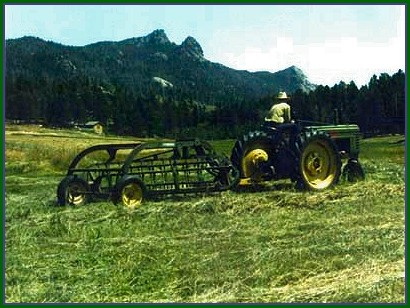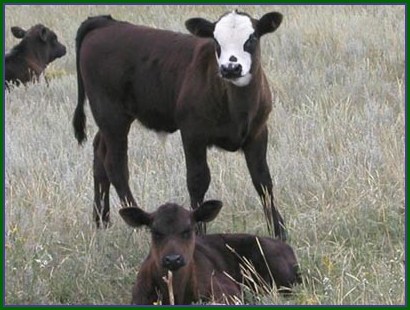About B Bar S Ranch
Frequently Asked Questions
 |
| Spring comes to the B Bar S Ranch highland pastures, near Nederland, Colorado, in Boulder County. |
"Many thanks to all at B Bar S Ranches. You’ve made it possible for my conscience to reconcile with my wallet and taste buds. Thank you. Thank you." |
- How does B Bar S Ranch beef differ from supermarket beef?
- How can B Bar S Ranch afford to keep their beef prices competitive?
- How much will I pay for B Bar S Ranch freezer-beef?
- What does Grass-finished mean?
- Is organic beef the same as grass-finished beef?
- How does trimming affect grass-finished beef?
- What is the risk of E. coli infection in grass-finished beef?
- Do you add antibiotics to your feed?
and Answers....
- How does B Bar S Ranch beef differ from supermarket beef?
B Bar S Ranch freezer beef is naturally raised and grass-finished, with no antibiotics and no growth implants. Our cattle spend 90 days prior to harvest on mountain ground with fresh water, exercise, and sunshine. Only 20 to 30 percent of the calories from our beef comes from fat. This is about the same as a breast of chicken with the skin removed. Unlike USDA-graded supermarket beef, we use no hormonal growth stimulants, appetite enhancers or antibiotics.
- How can B Bar S Ranch afford to keep their beef prices competitive?
It costs more to raise beef naturally, without antibiotics, growth stimulants, or feed additives. Because we eliminate the middle man, our beef costs about the same as you would pay in the supermarket for the same assortment of cuts.
- How much will I pay for B Bar S Ranch freezer-beef?
See our order page for complete information. Below are links to specific information. Close the new window to return to this page.
- How much beef should I order?
- When should I expect to receive my freezer beef?
- What cuts of beef will I get?
- How do I figure out what I will pay?
- How do I order my freezer-beef?
Taking orders now for 2024 Delivery
- How much beef should I order?
- What does naturally grown, grass-finished mean?
Commercial beef, the beef one buys in the supermarket, has been finished. This means that for 50 to 100 days (or more) the animal has been fed large quantities of high-calorie feed, primarily corn. High-calorie feed does the same thing to cattle as it does to us -- it makes them fat. And when we eat the meat from such animals, the fat is passed along to us.

Haying time. B Bar S Ranch hayfield, Nederland. Grass-finished cattle are not fed high-calorie feeds. Rather, they are allowed to eat green grass or grass hay (sometimes alfalfa). Grass-finished cattle do not become fat in the way grain-finished animals do. The meat from them is leaner and healthier.
Trimming helps reduce fat, but within red meat there are little bits of fat called marbling, which cannot be removed with a knife. Even after careful trimming, beef from grain-finished cattle still contains more fat than beef from grass-finished animals.
Meat from grass-finished animals is also higher in omega-3 fatty acids, beta carotene and conjugated linoleic acid than grain-finished beef.
For more information about grass-finished beef, check out Eatwild.com (The Clearinghouse for Information about Pasture Based Farming)
-
Is organic beef the same as grass-fed beef?
The designations organic or certified organic do not mean grass-fed, or grass-finished. Coleman Beef, for example, is organic, but it is also grain-fed and is higher in fat than our grass-finished beef. To qualify as grass-fed, the American Grass-fed Association requires that 95% or more of the animal's primary energy source be grass, legumes (e.g., alfalfa, clover) or forages. Our animals satisfy this criterion. Our grass-finished beef meets this criteria.
-
How does trimming affect grass-fed beef?
Trimming all separable fat from grass-fed beef drops the percentage of calories from fat to below 20 percent. After 97 days of feeding grain, this figure rises to 31%. (Cook, W., et al., CSU Experiment Station, Bulletin 5795, 1983; Leandere, et al., Journal of Animal Science, 1978, 46, 965-970) For USDA Choice beef it jumps to 47%. (USDA, Composition of Foods: Beef Products, 1986, 8-13)
Properly trimmed, grass-fed beef contains less fat and cholesterol than whole chicken. It contains only slightly more fat, and about the same amount of cholesterol, as the white meat of chicken with the skin removed. Some fish is higher in fat (e.g. , halibut and salmon) and some contains as much or more cholesterol (e.g., catfish, pike, and salmon) as well-trimmed grass-fed beef. Three-and-one-half ounces of shrimp contains little fat, but more than twice the cholesterol, and one egg contains more than four times the cholesterol found in a 3.5-ounce serving of well-trimmed, grass-fed beef. USDA, Composition of Foods, Series B, 1979-1986)
Incidentally, trimming all separable fat cuts the calories in a 3.5-ounce serving from 250-plus to less than half that. In the fight against fat, a little trimming goes a long way.
-
What is the risk of E. coli infection in grass-fed beef?
Every year, hundreds of Americans fall ill to infection by E. coli bacteria, and some of them die. Young children are especially vulnerable.
Infection can come from a number of sources, including vegetables and fruit juice, but commercial ground beef is a common culprit in the U.S.
For two reasons, grass-fed beef virtually eliminates the risk of E. coli infection. (Focus. Cattle Diet Linked to Bacterial Growth, Science, 1998, 281, 1578-1579; F. Diez-Gonzalez, et al., Science, 1998, 281, 1666-1668)

Healthy, content beef calves on B Bar S Ranch summer pasture. In the first place, low acidity in the digestive tracts of grass-fed animals discourages the growth of E. coli bacteria. Secondly, those bacteria that do grow in the grass-fed animal are easily destroyed by the high acidity of the human stomach. (Surviving E. coli from the digestive tracts of a corn-fed animals have adapted to higher acidity, and the high acidity of the human stomach provides little protection against them.)
-
Do you add antibiotics to your feed?
Low doses of antibiotics slightly increase growth rates in farm animals, while using less feed. Most livestock raised for human consumption are fed antibiotics. Our cattle are never fed antibiotics, and if an animal must be treated with antibiotics for health reasons, it is not included in our freezer-beef program.
Feeding low doses of an antibiotic favors the survival of bacteria that are resistant to it. If such resistant bacteria infect humans (as they sometimes do), these antibiotics would be ineffective in treating the infection.
The World Health Organization (WHO) recently called for the elimination of the routine use of antibiotics in livestock feed. This would benefit human health without damaging animal health or reducing farmer income. (Focus. WHO Advises Kicking the Livestock Antibiotic Habit. Science, 2003, 301,1027)
"Thank you for the beef. It is wonderful to know we are eating healthy meat. (Jerry and Joyce also did a good job.")
